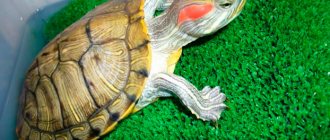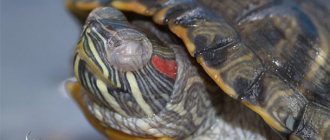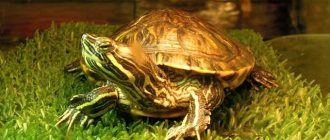Home / Lighting / Flora and fauna
Back
Reading time: 5 min
0
80
An ultraviolet lamp for the red-eared turtle and other representatives of this family is a mandatory element that must be placed in the aquarium. Without it, it is impossible to ensure the normal functioning of reptiles, so it is worth taking care of this type of lighting in advance.
- Features of keeping turtles
- Effect of ultraviolet light on turtles
- Types of UV Lamps
- Lamp operating time, location, whether they are harmful to humans
Why is it needed?
In its natural habitat, the turtle receives full solar radiation necessary for its life. When a person tries to tame an animal, he places it in housing where there is no direct ultraviolet radiation. Without it, your pet will begin to develop diseases, which will lead to dire consequences. This is especially true for young and pregnant individuals.
Lack of calcium leads to softening and deformation of the shell. In this case, the disease rickets develops, which leads to bone fractures or death of the animal.
To avoid troubles, a lamp for the terrarium is installed. Its UV radiation can replace the sun, calcium and vitamins from food will begin to be absorbed in the body, and the turtle will live a full life. In addition, radiation also improves the organs of vision. The visible picture is perceived more clearly and all colors are displayed.
There are red-eared turtles and land turtles. For the red-eared slider, the need for vitamin D3 is replenished by eating algae and small water inhabitants. Therefore, the need for a lamp is not put in first place. For the land turtle, the presence of ultraviolet light is very important, since the vitamin is not absorbed without it.
An ultraviolet lamp for turtles is installed directly above the animal. Through the glass of the aquarium, ultraviolet radiation will not penetrate the animal.
Terms of use
If in winter the room where the pet lives is cool, then in addition to light, the light bulb should also provide heat. But you should not install it closer than 30 centimeters to the animal. Close proximity will lead to burns of soft tissues and the ocular surface.
For an active turtle, it is enough to maintain a temperature of up to 30 degrees during the daytime and up to 25 degrees at night.
In order for an aquatic turtle to live and feel fully, the terrarium must contain two zones: water (cool), land (warm).
The maximum temperature of the warm zone is up to 40 degrees.
The water level is also taken into account. When turning the animal onto its back, there should be enough space to return to its original position.
There are three types of lamps sold in stores:
- tubular;
- compact;
- metal-steam.
The installation of these types is different. Tubular ones require the installation of the required lampshade or grooves. Compact ones are screwed into a standard E27 base. To operate a metal vapor lamp, you need a special starter. The first option is suitable for lighting large terrariums, while compact ones are suitable for small aquariums.
When installing, the location of the lamp is also taken into account so that the animal cannot loosen it. The wiring must be in good working order to prevent electric shock.
Thus, for correct placement the following nuances are taken into account:
- type of ultraviolet light bulb;
- distance between the lamp and the animal;
- type of pet;
- temperature regime;
- lighting area.
Lighting should be uniform throughout the entire boxing area. No dark areas allowed.
Do not install lamps on the side. This will irritate the animal.
If the lamp is intended for heating reptiles, then it should work only during the daytime and should be turned off at night. An infrared lamp is often used to maintain temperature.
Also, the operating time of the ultraviolet source depends on the age of the turtle:
- up to two years of age, the animal requires more lighting and warmth;
- after two years, the perception of UV rays is lost, so the source is used for a short period of time - up to three hours.
If it is not possible to constantly monitor the lighting, then you need to install an ultraviolet light bulb with automatic shutdown. It is equipped with a timer that is programmed for the desired period of inclusion.
Some owners install Photon lamps in terrariums. But they are used to apply tanning and for the animal the switching on is carried out for no more than five minutes.
One of the main tasks of the owner of a Central Asian tortoise is to provide his pet with the temperature and lighting conditions necessary for the reptile. Why is this so important?
It is no secret that turtles are cold-blooded creatures that are not able to regulate their body temperature themselves. That is, in order to digest food, the turtle must warm up to a certain temperature. Our body regulates these processes itself, we don’t even think about it, but what should a cold-blooded reptile do in such a situation?
The only way out is to find a warmer place and warm up yourself due to the external temperature. This is why you can see various types of reptiles basking on warm stones under the sun, and for the same reason turtles kept on the floor love to crawl under the radiator.
You can guess that lying sleepy in a warm place for a turtle is not a lazy pastime, but a vital process necessary for a full life. Food eaten by a cold-blooded animal will not be digested or absorbed without a certain temperature, causing only fermentation and discomfort in the body.
One can imagine the responsibility the holder of a reptile takes on. After all, it must ensure not only the processes of feeding and hygiene, as in the situation with a warm-blooded pet, but also the process of digesting food on it.
It’s understandable that a turtle’s body temperature rises, but what to do in a situation where the body needs to cool down, on the contrary? The answer is the same - find a cooler place. In such cool corners, the turtle settles down for the night, and during the day it may prefer the cold shade to the sun. That is, it is necessary to organize a home for the turtle, in which it will choose a warm or cool place to regulate its temperature.
Now the size of the terrarium becomes clear (at least 70x40 cm at the base). In a smaller terrarium, it is impossible to achieve a temperature difference.
So, we organize warm and cold corners in the terrarium.
In a warm corner we install an incandescent lamp of 40-60 W. The choice of power will depend on the height at which you install the lamp. Where the turtle is lying, the temperature should be 31-33 degrees. Using the height of the lamp and the power of the lamp itself, this is easy to achieve. Usually the lamp is installed at a height of 20-25 cm from the turtle’s shell; the temperature must be checked with a thermometer. It is very convenient to use lamps on a clothespin; they can be purchased at electrical and pet supply stores.
The opposite corner automatically becomes cold, its temperature should not exceed 25-27 degrees, and at night it should not fall below +18 ° C. If the apartment is cold and the temperature at night is too low, then it is necessary to install an infrared night lamp in the terrarium for heating.
Thermometers are permanently installed in both the warm and cold corners to monitor temperatures.
The light regime is also important for the comfortable existence of the turtle. Organizing it is not that difficult. The installed incandescent lamp will fully satisfy the reptile's need for lighting (but not ultraviolet light, we will talk about it separately).
After installing the lamp with an incandescent lamp, you will only have to decide on the lighting and heating mode. Usually this is 11-12 hours of daylight. For example, from 8 a.m. to 8 p.m. It is better to stick to the same times for turning on and off the lamps (meaning lamps with incandescent and ultraviolet lamps). Turtles are very good at sticking to routines. Having decided on the operating time of the lamps, you will soon notice that your turtle goes to bed a few minutes before they turn off, and also wakes up in the mode you have chosen.
Special mechanical or electronic timers will help you with maintaining the lighting regime, to which you can connect lamps and set the desired time. Smart plugs are also very convenient. These devices are indispensable when leaving for the weekend or on urgent matters, especially since you don’t need to feed the turtle every day, and an extra fasting day will only be beneficial.
Once you take care of organizing the conditions for your cold-blooded pet, you will enjoy watching the reptile’s comfortable life for many years.
Tips for choosing ultraviolet lamps
When purchasing UV lamps for turtles, you should follow these tips:
- It is recommended to buy light bulbs containing a standard base;
- small sizes give off less light;
- for mercury-containing lamps a special starter is needed;
- terrariums use lighting from 5% UVB to 12%.
It is also worth considering which lamps you do not need to buy for turtles:
- a blue light bulb used for treatment and warming;
- UV for illumination of banknotes;
- ultraviolet source for quartzization;
- honey light bulbs;
- for lighting aquariums;
- product with no UVB percentage;
- for drying nail plates.
We recommend watching the video:
TOP manufacturers
The best manufacturers of UV lamps for turtles are:
- LUCKY REPTILE 30% UVA and 6.0, 5.0 UVB - suitable for all types of turtles. Installation is carried out at a distance of 30 cm from the animal.
- NARVA Special 30% UVA and 4% UVB - suitable for all types of turtles. Installation is carried out at a distance of 25 to 45 cm from the animal.
- Repti Zoo 5.0, 10.0, 15 W and 26 W (compact) – 5.0 for the land species, 10.0 for the red-eared species. Distance 15–20 cm.
- Arcadia D3 Reptile Lamp 6% (for healthy turtles), 12% UVB (tubes), D3 UV BASKING LAMP, D3 (compact) 6%, 10% UVB (for pregnant, young turtles). Distance 30–40 cm.
- ZooMed produces – 5.0 (red-eared species) and 10.0 (land species) compact, long – lighting and heating source. The source is replaced once a year. Distance 40–50 cm.
- SERA T 8 Terra UV-special 30% UVA and T8 4% UVB – lamp length 45–105 cm for placement in large boxes. The installation height is 15–20 cm from the animal.
It is also worth checking which UV lamp is suitable for which type of turtle.
Types of UV lamps
Depending on the device, UV lamps have several types: 1. Fluorescent lamps (long tubes) with an ultraviolet spectrum were among the first to appear on sale. Each of these models has a certain range at which they are guaranteed to emit the number of units of ultraviolet radiation. Most often, the maximum range declared by the manufacturer is 50 cm. The number of units of UV spectrum B (denoted as UVB) is indicated by an integer with a zero at the end (10.0; 6.0; 5.0.). A UV lamp for turtles also emits spectrum A. This spectrum stimulates the natural behavior of animals, and is very necessary for plants in the terrarium. Models made in China have a service life of no more than six months. And manufacturers from Europe and Germany have a service life of 12 months. 2. A few years ago they started producing compact ones with an E27 cartridge. They are also luminescent. They are divided according to the amount of ultraviolet light (UVB) emitted, for example: 2.0, 10.0 and 5.0. In terms of their properties, compact ones are not inferior to “tubes”. They come in 26 W and 13 W power. Their service life is slightly longer than that of tubes. Compact lamps from Chinese manufacturers emit the required amount of UV for no more than 7 months. And the European or German version is a little over a year old. 3. A less common option is mercury (metal vapor). They provide a more powerful stream of light (full spectrum) and heat. Ultraviolet lamps emit rays of the A and B spectrum. Spectrum B – helps to absorb calcium in the body, Spectrum A – increases perception and stimulates natural behavior in animals. This spectrum especially affects the reproduction of offspring. For installation in an aquarium, additional lighting is suitable for cold-blooded animals, having in its rays 30% of the A spectrum and 5-12% of the B spectrum. For turtles living in water, which include the species of red-eared turtles, a lamp with 5.0 to 8.0 B spectrum is installed, and for land turtles species should not be lower than 10-12% UVB, for female red-eared turtles expecting offspring, young animals 8-12%. The manufacturer indicates the relevant parameters on the packaging.
Service life
Each package of ultraviolet light bulbs contains information about the service life. If you use it correctly, a high-quality product will fully work for the specified time. If the period has already expired and the lamp is still working, then do not forget that it is no longer so effective, since the fluorescent burns out during the warranty period.
This lamp is suitable for regular lighting for plants and aquariums.











